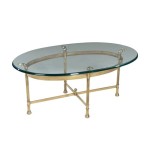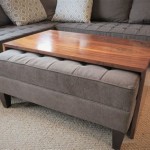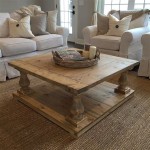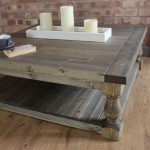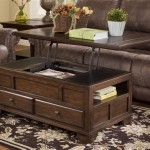What Is The Average Dimensions Of A Coffee Table?
The coffee table, a ubiquitous piece of furniture in living rooms and reception areas, serves a dual purpose: it provides a surface for placing beverages, books, and decorative items, while also contributing to the overall aesthetic of the room. Determining the "average" dimensions of a coffee table, however, is not a simple matter. Coffee table sizes vary significantly based on factors such as the size of the seating arrangement, the height of the sofa, the available space in the room, and the desired style. Understanding these factors is crucial when selecting a coffee table that complements the existing furniture and fulfills the intended function.
While a precise average measurement is elusive, we can establish a range based on common designs and ergonomic considerations. This discussion will explore the typical dimensions of coffee tables, the factors influencing these dimensions, and offer guidance on how to choose the appropriate size for any given room. Specifically, we will address the length, width, and height considerations, as well as the spacing and clearance requirements for comfortable use.
Typical Length and Width Dimensions
The length and width of a coffee table are primarily determined by the size and layout of the surrounding seating area. Generally, the coffee table should be approximately two-thirds the length of the sofa. For example, if a sofa is 90 inches long, the coffee table should ideally be around 60 inches in length. This proportion creates a balanced visual appeal and allows for comfortable access from all seating positions. If the coffee table is too long, it can overwhelm the space and make it difficult to navigate the room. Conversely, if it is too short, it may appear insignificant and fail to provide adequate surface area for practical use.
In terms of width, coffee tables typically range from 24 to 36 inches. The ideal width depends on the distance between the sofa and any other seating elements, such as chairs or loveseats. A wider coffee table may be suitable for larger rooms where the seating is more spread out, providing ample space for placing items within easy reach. Narrower coffee tables are better suited for smaller spaces or when there's limited space between the sofa and other furniture. The goal is to ensure that the coffee table provides sufficient surface area without obstructing movement or creating a cramped feeling.
When considering length and width, it's also important to account for the shape of the coffee table. Rectangular coffee tables are the most common and generally adhere to the two-thirds length rule. Square coffee tables can work well in smaller spaces or when paired with sectional sofas, offering a symmetrical and balanced look. Round coffee tables are a good option for creating a softer, more inviting atmosphere and can be particularly useful in homes with young children, as they eliminate sharp corners. Oval coffee tables offer a similar aesthetic to round tables but provide more surface area.
Regardless of the shape, maintaining a proportional relationship between the coffee table and the sofa is key to achieving a cohesive and visually appealing living room arrangement. Consider measuring the available space and the dimensions of the sofa before making a purchase to ensure a proper fit. Scale is crucial in interior design, and the coffee table should complement, not compete with, the other elements in the room.
Height Considerations for Coffee Tables
The height of a coffee table is a crucial ergonomic factor that directly impacts its usability. Ideally, the coffee table should be the same height as the sofa cushions, or slightly lower. This allows for easy access to items placed on the table without having to reach up or bend over excessively. A coffee table that is too tall can be awkward to use and may even obstruct the view of the television or other focal points in the room.
The most common height range for coffee tables is between 16 and 18 inches. This height generally works well with standard-sized sofas. However, the height of the sofa itself should be taken into account. If the sofa has particularly high cushions, a slightly taller coffee table may be necessary. Conversely, if the sofa is low-slung, a lower coffee table will be more appropriate.
There are also variations in coffee table height to consider. For example, coffee tables designed for use with sectionals or pit groups may be lower, typically around 14 inches. This lower height complements the more relaxed and informal style of these seating arrangements. On the other hand, some coffee tables are designed to function as both a coffee table and a side table, and these may be slightly taller, around 20-22 inches. These taller coffee tables can be useful for tasks such as working on a laptop or enjoying a meal while seated on the sofa.
When selecting a coffee table height, consider the primary uses of the table. If it will primarily be used for placing drinks and snacks, a height that is level with or slightly below the sofa cushions is ideal. If it will be used for more functional purposes, such as working or eating, a slightly taller height may be preferable. It is always best to err on the side of caution and choose a coffee table that is slightly lower rather than too high, as a lower table is generally more comfortable and versatile.
Spacing and Clearance Guidelines
Beyond the length, width, and height, adequate spacing around the coffee table is essential for creating a functional and comfortable living space. The goal is to allow for easy movement around the table without feeling cramped or obstructed. Insufficient spacing can make the room feel smaller and less inviting, while excessive spacing can make the table feel disconnected from the rest of the furniture.
A general guideline is to leave between 14 and 18 inches of space between the coffee table and the sofa. This spacing allows for comfortable legroom and prevents people from bumping into the table when getting up or sitting down. If the room is smaller, it may be necessary to reduce the spacing slightly, but aim to maintain at least 12 inches for basic maneuverability. In larger rooms, you can increase the spacing to allow for a more open and airy feel.
It's also important to consider the distance between the coffee table and any other furniture, such as chairs, loveseats, or media consoles. Aim to leave at least 30 inches of space between the coffee table and these other pieces of furniture to allow for comfortable passage. This is especially important in high-traffic areas where people frequently walk through the room.
In addition to horizontal spacing, consider the vertical clearance underneath the coffee table. If you plan to use storage baskets or ottomans, ensure there is enough space underneath the table to accommodate them. This can help to maximize the functionality of the coffee table and keep the room organized. Similarly, if you have pets, consider the clearance underneath the table to ensure they can move freely around the room without getting stuck.
Finally, remember to consider the overall flow of the room when determining the placement and spacing of the coffee table. The coffee table should be positioned in a way that complements the existing furniture and facilitates easy movement throughout the space. Avoid placing the coffee table too close to doorways or walkways, as this can create a bottleneck and disrupt the flow of traffic. By carefully considering the spacing and clearance guidelines, you can create a living room that is both stylish and functional.
Ultimately, selecting the "average" dimensions of a coffee table is less about adhering to strict measurements and more about considering the specific needs of the room and the individuals using it. By carefully evaluating the size of the seating area, the height of the sofa, the available space, and the intended uses of the table, one can choose a coffee table that seamlessly integrates into the living space and enhances its overall functionality and aesthetic appeal.

Coffee Table Dimensions Size Guide Measurements

20 Coffee Table Standard Size Home Office Furniture Collections Check More At Http Www Buzzfo Height Dimensions

Standard Sofa Table Height Home Office Furniture Desk Check More At Http Www Nikkitsfun Com S Coffee Size Dimensions

Angel Furniture Solid Sheesham Wood Classic Coffee Table Standard Honeyfinish

Convenience Concepts Royal Crest 34 In Rose Gold Standard Height Round Glass Top Coffee Table With Shelf S14 141 The Home Depot

Average Coffee Table Height Complete Living Room Sets Check More At Http Www Buzzfolder Measurements Size Dining With Bench

Caleb Ceramic Round Coffee Table Scandesigns Furniture

Here S All You Need To Know About Your Coffee Table Dimensions Eathappyproject

Low Wooden Coffee Table Solid Center Tea

Coffee Table White Milwaee Beliani Fr
Related Posts

